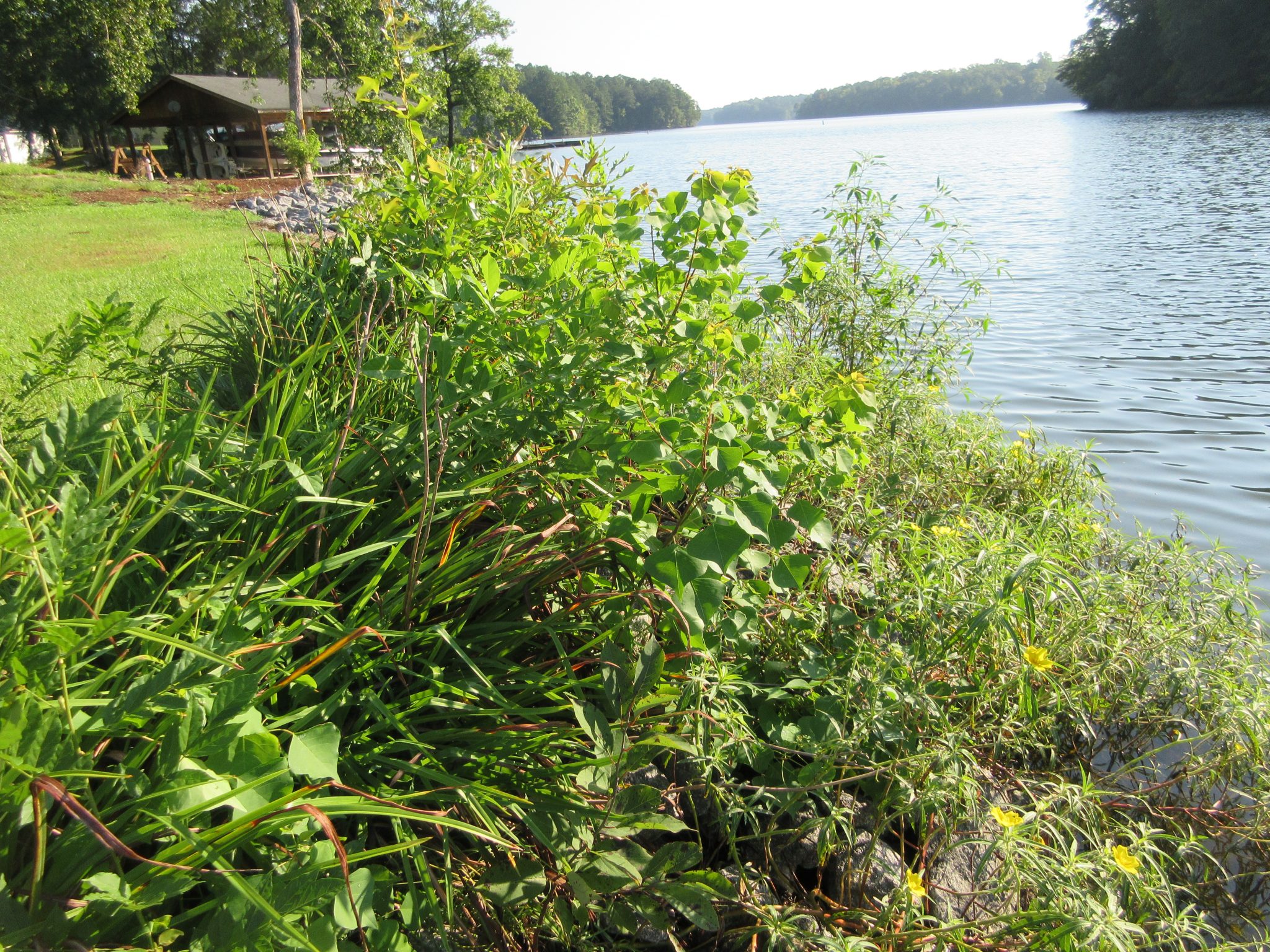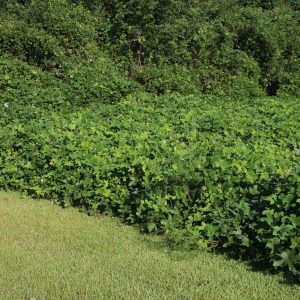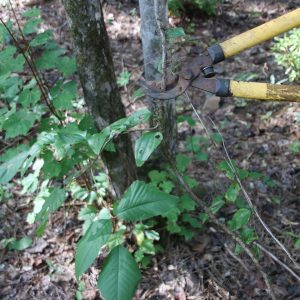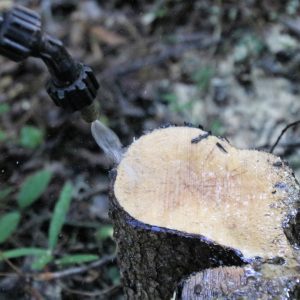Forestry & Wildlife

As summer draws to a close with the days becoming shorter and the nights longer, fall in Alabama typically ushers in days that are cooler and less humid. Mindsets shift to focus on Saturday football games or days spent outside doing our favorite recreational activities. However, fall also provides an excellent window of opportunity to clear overgrown brushy areas around homes or control unwanted invasive plants.
Overgrown Brush and Shrubs
Overgrown brush, especially invasive shrubs and trees is often unpleasant to look at and may attract unwanted wildlife, such as rodents and their predators—snakes. Many homeowners are likely familiar with regular trimming and brush cutting treatments to tidy up areas around the home, only to be dismayed at the rapid resprouting and regrowth that returns. This is due in part to the long growing season we have in Alabama and the propensity of many invasive plants to quickly assume their previous height of growth. In many cases, these plants can become even worse than before trimming.
For longer residual control, it is best to pair any mechanical trimmings with a herbicide application as well. You may ask: Shouldn’t we treat unwanted plants during the peak of the growing season when it is hot? While true in some cases, brush control is often most effective during the fall for multiple reasons. First, unlike during the summer where top growth is emphasized, many plants are focusing on storing energy in their root systems making them vulnerable to a well conducted herbicide treatment during the fall. Second, many desirable plants are deciduous and lose their leaves later in the fall, leaving them less susceptible to non-target damage. Lastly, brush control can be physically demanding, so cooler temperatures and lower humidity can reduce fatigue and help prevent injuries that may occur while working outdoors.
- Kudzu is a well-known invasive species in Alabama landscapes.
- Poison ivy vines should be cut and treated for maximum control.
- Treating stumps directly with a herbicide is an effective means of control.
Invasive Species
Chinese Privet
Chinese privet is the most commonly encountered nuisance shrub both around the home and in forested settings. Standard mechanical control options will often leave you exhausted and frustrated. This is because privet is a stump and lateral root sprouter, usually becoming worse after attempts to cut or dig up the plant. Privet maintains foliage throughout the year so it’s a good one to treat later in the fall or winter when other hardwoods are dormant. Plants that are at head height or less can usually be treated with a foliar spray as long as daytime temperatures reach the 50s and cooler temperatures do not persist. This method is especially popular later in the fall and early winter once many native trees and shrubs have dropped their leaves. This gives you the ability to see all the privet that is occurring and safely allows a foliar application to the privet without damaging desirable trees.
If privet is taller or there is concern for herbicide runoff or drift, cut-stump treatments are highly effective. This method involves cutting the stem close to the ground and quickly applying herbicide to the stump. Applying directly to the stump reduces the amount of herbicide that may runoff and it quickly targets the root system of the plant. This can easily be done by mixing at least a 25 percent mixture of glyphosate. Make sure the active ingredient is at least 41 percent active ingredient and treat the stump immediately after cutting. For larger areas, mechanical mulching using a skid-steer mulcher is a great option to quickly reclaim areas infested with privet. Keep in mind that all the mulched stems will re-sprout in the spring and a herbicide application will need to be made for long-term control.
Chinese Tallowtree
An invasive tree that is becoming increasingly more troublesome is the Chinese tallowtree. Tallowtrees, also commonly called “popcorn” trees due to their white budding flowers that resemble popcorn, have the potential to be very problematic around Lake Martin and surrounding bodies of water. This is due to the mass seed production and the ability of tallowtree seed to easily disperse in water. In other areas of the state, especially along the Alabama River, tallowtrees are now the predominate riparian trees and threaten the biodiversity in these riparian areas. If there is a tallowtree planted or growing in your yard, consider replacing it with a native tree species. Similar to control for Chinese privet, the cut stump treatment is highly effective for controlling these nuisance trees.
Kudzu
Whereas many invasive plants are not recognizable to the general public, kudzu has long been a staple in the invasive plant dictionary for many southerners. Despite being so well known, it continues to baffle many that try to control it. Kudzu has a large root system that is loaded with energy reserves. These reserves are what allows it to re-sprout vigorously after standard vegetation control techniques such as mowing or treatment with over-the-counter lawn herbicides.
Kudzu can be tricky because it is usually growing over or beneath some desirable tree species. The mats of vines and leaves that kudzu forms also makes it difficult to obtain good coverage during a foliar leaf application. In addition, many herbicides that are highly effective on kudzu are also soil active and may damage trees you wish to keep. However, for small infestations or in areas where you can get some help, another effective method for controlling kudzu that does not require herbicides is root crown removal. A common misconception is that all roots of kudzu must be removed to control the plant. That is not the case, and if you trace each vine to where it roots in the soil you will find a ball of buds and new sprouts called the root crown. A shovel or pickax is useful to the expose the root crown and then a large set of lopping shears or hatchet can be used to remove the root crown from the soil.
Poison Ivy
Another common vine that often can be a headache and also cause a terrible rash is poison ivy. Although a native plant with many wildlife benefits, its sap contains a chemical called urushiol, which causes the terrible itching and blisters associated with poison ivy. Poison ivy growing on the ground can easily be sprayed and controlled. If you take the time to look up the trees surrounding your property, more than likely you’ll see larger poison ivy vines climbing the tree trunks. These larger vines produce more poison ivy seed and attract more birds that spread the seed. For long term reduction in poison ivy, it’s a good idea to treat these vines. However, the chemical urushiol exists in all parts of the plant including the stem. Cutting the stem and treating with a herbicide is highly effective but more care must be made to avoid throwing dust or chips of the stem back towards your body. Pruning shears or lopping shears are two tools that you can use to cut the stem without dispersing urushiol into the air.
Herbicide Applications
Prior to any herbicide application, do some background work before beginning the treatment program. Always be sure to check the label of any herbicide and note the active ingredients and any limitations to where it can be applied. For example, many over the counter “brush killers” may include soil active herbicides such as imazapyr. Imazapyr can move in the soil and damage desirable trees nearby. In the past year several homeowners had conducted some mulching of privet and tallowtrees and sprayed one of these types of brush killer herbicides on the regrowth the following year, only to be devastated when their oaks and other hardwoods began to die.
Also, some herbicides are not allowed to be sprayed in or near water, so keep that in mind when spraying vegetation along the shores of the lake or any streams. There is not always a standard “umbrella” approach to brush control and many cases may call for different prescriptions. If you are unsure of what type of treatment suits your needs or the specific herbicide to use, feel free to reach out to your local Alabama Cooperative Extension office and agents will be glad to assist you. The Alabama Extension website also contains a vast amount of information on identification and control of many undesirable plant species.




